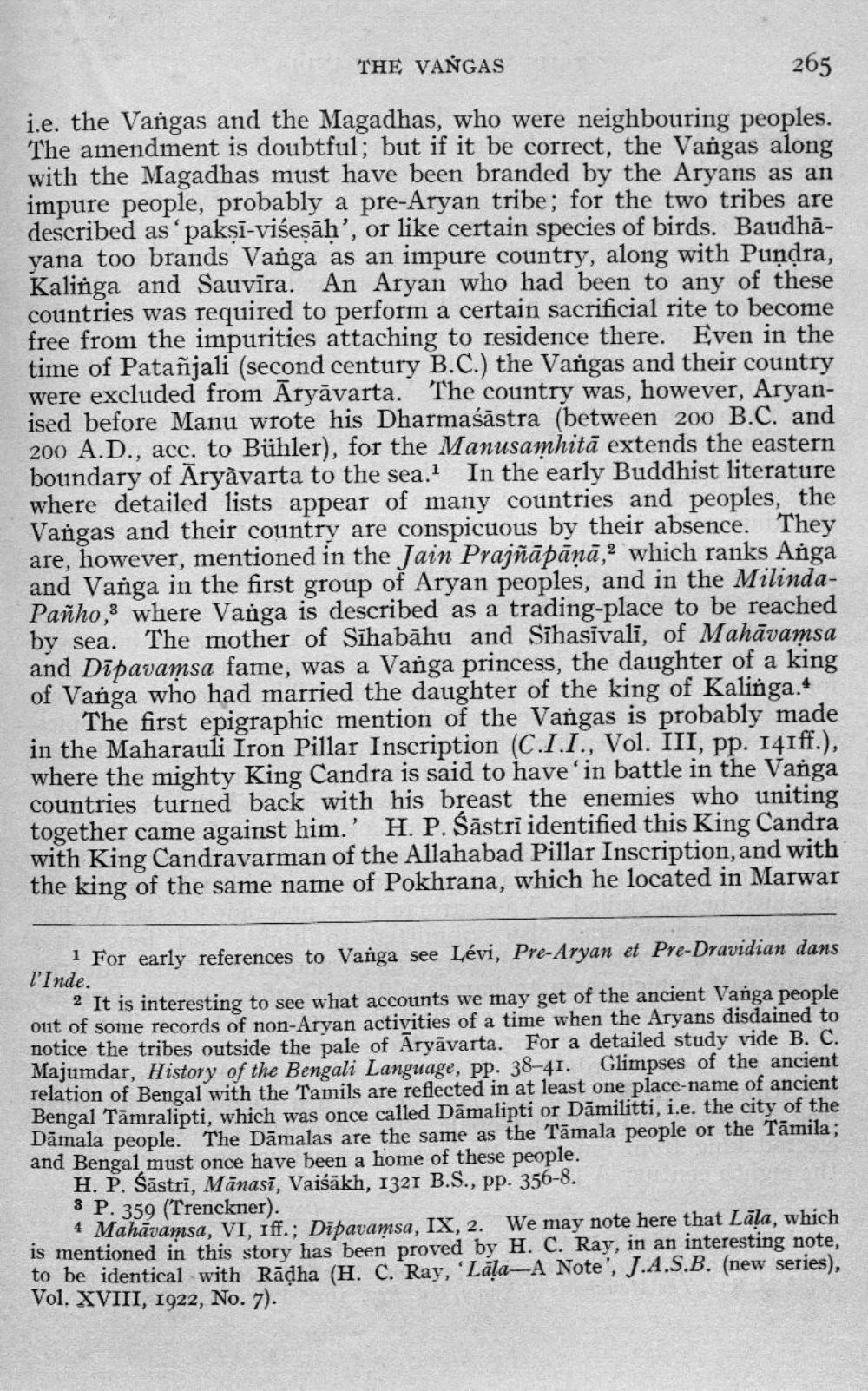________________
THE VANGAS
265
i.e. the Vangas and the Magadhas, who were neighbouring peoples. The amendment is doubtful; but if it be correct, the Vangas along with the Magadhas must have been branded by the Aryans as an impure people, probably a pre-Aryan tribe; for the two tribes are described as paksi-višesāh' or like certain species of birds. Baudhāyana too brands Vanga as an impure country, along with Pundra, Kalinga and Sauvīra. An Aryan who had been to any of these countries was required to perform a certain sacrificial rite to become free from the impurities attaching to residence there. Even in the time of Patañjali (second century B.C.) the Vargas and their country were excluded from Āryāvarta. The country was, however, Aryanised before Manu wrote his Dharmaśāstra (between 200 B.C. and 200 A.D., acc. to Bühler), for the Manusamhitā extends the eastern boundary of Āryàvarta to the sea. In the early Buddhist literature where detailed lists appear of many countries and peoples, the Vangas and their country are conspicuous by their absence. They are, however, mentioned in the Jain Prajñāpāņā, 2 which ranks Anga and Vanga in the first group of Aryan peoples, and in the MilindaPañho, where Vanga is described as a trading-place to be reached by sea. The mother of Sīhabāhu and Sīhasivali, of Mahāvamsa and Dīpavamsa fame, was a Vanga princess, the daughter of a king of Vanga who had married the daughter of the king of Kalinga.
The first epigraphic mention of the Vangas is probably made in the Maharauli Iron Pillar Inscription (C.I.I., Vol. III, pp. 141ff.), where the mighty King Candra is said to have in battle in the Vanga countries turned back with his breast the enemies who uniting together came against him.' H. P. Šāstri identified this King Candra with King Candravarman of the Allahabad Pillar Inscription, and with the king of the same name of Pokhrana, which he located in Marwar
1 For early references to Vanga see Lévi, Pre-Aryan et Pre-Dravidian dans l'Inde.
2 It is interesting to see what accounts we may get of the ancient Vanga people out of some records of non-Aryan activities of a time when the Aryans disdained to notice the tribes outside the pale of Aryāvarta. For a detailed study vide B. C. Majumdar, History of the Bengali Language, pp. 38-41. Glimpses of the ancient relation of Bengal with the Tamils are reflected in at least one place-name of ancient Bengal Tāmralipti, which was once called Dāmalipti or Dāmilitti, i.e. the city of the Dāmala people. The Dāmalas are the same as the Tamala people or the Tāmila; and Bengal must once have been a home of these people.
H. P. Šāstri, Mānasi, Vaisakh, 1321 B.S., pp. 356-8. 3 P. 359 (Trenckner).
4 Mahāvamsa, VI, Iff.; Dipavamsa, IX, 2. We may note here that Lāla, which is mentioned in this story has been proved by H. C. Ray, in an interesting note, to be identical with Rādha (H. C. Ray, 'Lāla-A Note', J.A.S.B. (new series), Vol. XVIII, 1922, No. 7).




